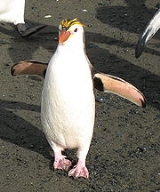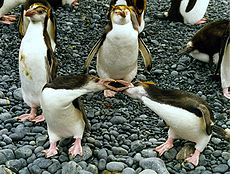
Royal Penguin
Encyclopedia
The Royal Penguin inhabits the waters surrounding Antarctica. Royals look very much like Macaroni Penguin
s, but have a white face and chin instead of the Macaronis' black visage. They are 65–76 cm (25.6–29.9 in) long and weigh 3–8 kg (6.6–17.6 lb). Males are larger than females. Royal Penguins breed only on Macquarie Island
and, like other penguin
s, spend much of their time at sea, where they are assumed to be pelagic
. They are not to be confused with the similar named King Penguin
or Emperor Penguin
.

 There is some controversy over whether Royal Penguins are a sub-species of Macaroni Penguins. Individuals of the two groups have been known to interbreed, though this is a relatively rare occurrence. Indeed, other penguins have been known to form mixed-species pairs in the wild.
There is some controversy over whether Royal Penguins are a sub-species of Macaroni Penguins. Individuals of the two groups have been known to interbreed, though this is a relatively rare occurrence. Indeed, other penguins have been known to form mixed-species pairs in the wild.
Royal Penguins nest on beaches or on bare areas on slopes covered with vegetation. Like most seabird
s they are colonial, nesting in scrapes on the ground up to a mile inland. The breeding season begins in September with laying starting in October. Two eggs are incubated for 35 days, with each incubation stint lasting up to two weeks. After brooding the chick for three weeks, both parents forage at sea while the chicks form large creche
s. The chicks fledge
after two months. Young adults usually return to the colony to breed after six years.
Royal Penguins feed on krill, fish, and small amounts of squid. They build their nest by making a shallow hole in the sand or in a weeded area. They put plants and stones inside the nest. Most of the time, two eggs are often laid, however, only one survives. The egg is kept warm by both parents for 35 days. This is done by rotating 12 day shifts. After hatching, the male watches out for the chick for 10 to 20 days and the female brings food for both of them. Around 20 days, the chicks will form a home for warmth and safety. The parents continue to feed it 2 to 3 times a day. When the chick is about 65 days old it will have its adult feathers and goes on its own.
Royal Penguins are not considered threatened; historically they were harvested for their oil, between 1870 and 1919 the government of Tasmania
issuing licences for hunting them, with an average 150,000 penguins (both Royal and King) being taken each year. At the peak of the industry in 1905, the plant established on Macquarie Island was processing 2000 penguins at a time with each penguin producing about half a litre of oil.
Since the end of penguin hunting on Macquarie the numbers have climbed to 850,000 pairs. Before hunting started, there were 3 million penguins on the island (both Royal and King).
The scientific name commemorates the German zoologist Hermann Schlegel
.

Macaroni Penguin
The Macaroni Penguin is a species of penguin found from the Subantarctic to the Antarctic Peninsula. One of six species of crested penguin, it is very closely related to the Royal Penguin, and some authorities consider the two to be a single species...
s, but have a white face and chin instead of the Macaronis' black visage. They are 65–76 cm (25.6–29.9 in) long and weigh 3–8 kg (6.6–17.6 lb). Males are larger than females. Royal Penguins breed only on Macquarie Island
Macquarie Island
Macquarie Island lies in the southwest corner of the Pacific Ocean, about half-way between New Zealand and Antarctica, at 54°30S, 158°57E. Politically, it has formed part of the Australian state of Tasmania since 1900 and became a Tasmanian State Reserve in 1978. In 1997 it became a world heritage...
and, like other penguin
Penguin
Penguins are a group of aquatic, flightless birds living almost exclusively in the southern hemisphere, especially in Antarctica. Highly adapted for life in the water, penguins have countershaded dark and white plumage, and their wings have become flippers...
s, spend much of their time at sea, where they are assumed to be pelagic
Pelagic zone
Any water in a sea or lake that is not close to the bottom or near to the shore can be said to be in the pelagic zone. The word pelagic comes from the Greek πέλαγος or pélagos, which means "open sea". The pelagic zone can be thought of in terms of an imaginary cylinder or water column that goes...
. They are not to be confused with the similar named King Penguin
King Penguin
The King Penguin is the second largest species of penguin at about , second only to the Emperor Penguin. There are two subspecies—A. p. patagonicus and A. p...
or Emperor Penguin
Emperor Penguin
The Emperor Penguin is the tallest and heaviest of all living penguin species and is endemic to Antarctica. The male and female are similar in plumage and size, reaching in height and weighing anywhere from . The dorsal side and head are black and sharply delineated from the white belly,...
.


Royal Penguins nest on beaches or on bare areas on slopes covered with vegetation. Like most seabird
Seabird
Seabirds are birds that have adapted to life within the marine environment. While seabirds vary greatly in lifestyle, behaviour and physiology, they often exhibit striking convergent evolution, as the same environmental problems and feeding niches have resulted in similar adaptations...
s they are colonial, nesting in scrapes on the ground up to a mile inland. The breeding season begins in September with laying starting in October. Two eggs are incubated for 35 days, with each incubation stint lasting up to two weeks. After brooding the chick for three weeks, both parents forage at sea while the chicks form large creche
Crèche (zoology)
The Crèche in zoology refers to care of another's offspring, for instance in a colony. This term is used in the study of bird colonies...
s. The chicks fledge
Fledge
Fledge is the stage in a young bird's life when the feathers and wing muscles are sufficiently developed for flight. It also describes the act of a chick's parents raising it to a fully grown state...
after two months. Young adults usually return to the colony to breed after six years.
Royal Penguins feed on krill, fish, and small amounts of squid. They build their nest by making a shallow hole in the sand or in a weeded area. They put plants and stones inside the nest. Most of the time, two eggs are often laid, however, only one survives. The egg is kept warm by both parents for 35 days. This is done by rotating 12 day shifts. After hatching, the male watches out for the chick for 10 to 20 days and the female brings food for both of them. Around 20 days, the chicks will form a home for warmth and safety. The parents continue to feed it 2 to 3 times a day. When the chick is about 65 days old it will have its adult feathers and goes on its own.
Royal Penguins are not considered threatened; historically they were harvested for their oil, between 1870 and 1919 the government of Tasmania
Tasmania
Tasmania is an Australian island and state. It is south of the continent, separated by Bass Strait. The state includes the island of Tasmania—the 26th largest island in the world—and the surrounding islands. The state has a population of 507,626 , of whom almost half reside in the greater Hobart...
issuing licences for hunting them, with an average 150,000 penguins (both Royal and King) being taken each year. At the peak of the industry in 1905, the plant established on Macquarie Island was processing 2000 penguins at a time with each penguin producing about half a litre of oil.
Since the end of penguin hunting on Macquarie the numbers have climbed to 850,000 pairs. Before hunting started, there were 3 million penguins on the island (both Royal and King).
The scientific name commemorates the German zoologist Hermann Schlegel
Hermann Schlegel
Hermann Schlegel was a German ornithologist and herpetologist.-Early life and education:Schlegel was born at Altenburg, the son of a brassfounder. His father collected butterflies, which stimulated Schlegel's interest in natural history...
.

External links
- BirdLife Species Factsheet.
- ARKive - images and movies of the Royal Penguin (Eudyptes schlegeli)
- Australian Antarctic Division: Unusual Penguins Contains picture of mixed species pairs and hybrid individual penguins.
- www.pinguins.info : information about all species of penguins

